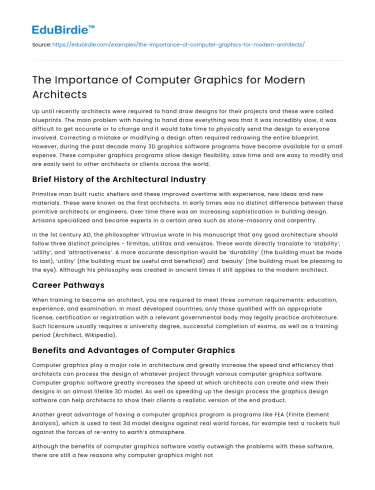Up until recently architects were required to hand draw designs for their projects and these were called blueprints. The main problem with having to hand draw everything was that it was incredibly slow, it was difficult to get accurate or to change and it would take time to physically send the design to everyone involved. Correcting a mistake or modifying a design often required redrawing the entire blueprint. However, during the past decade many 3D graphics software programs have become available for a small expense. These computer graphics programs allow design flexibility, save time and are easy to modify and are easily sent to other architects or clients across the world.
Brief History of the Architectural Industry
Primitive man built rustic shelters and these improved overtime with experience, new ideas and new materials. These were known as the first architects. In early times was no distinct difference between these primitive architects or engineers. Over time there was an increasing sophistication in building design. Artisans specialized and became experts in a certain area such as stone-masonry and carpentry.
Save your time!
We can take care of your essay
- Proper editing and formatting
- Free revision, title page, and bibliography
- Flexible prices and money-back guarantee
In the 1st century AD, the philosopher Vitruvius wrote in his manuscript that any good architecture should follow three distinct principles - firmitas, utilitas and venustas. These words directly translate to ‘stability’, ‘utility’, and ‘attractiveness’. A more accurate description would be ‘durability’ (the building must be made to last), ‘utility’ (the building must be useful and beneficial) and ‘beauty’ (the building must be pleasing to the eye). Although his philosophy was created in ancient times it still applies to the modern architect.
Career Pathways
When training to become an architect, you are required to meet three common requirements: education, experience, and examination. In most developed countries, only those qualified with an appropriate license, certification or registration with a relevant governmental body may legally practice architecture. Such licensure usually requires a university degree, successful completion of exams, as well as a training period (Architect, Wikipedia).
Benefits and Advantages of Computer Graphics
Computer graphics play a major role in architecture and greatly increase the speed and efficiency that architects can process the design of whatever project through various computer graphics software. Computer graphic software greatly increases the speed at which architects can create and view their designs in an almost lifelike 3D model. As well as speeding up the design process the graphics design software can help architects to show their clients a realistic version of the end product.
Another great advantage of having a computer graphics program is programs like FEA (Finite Element Analysis), which is used to test 3d model designs against real world forces, for example test a rockets hull against the forces of re-entry to earth’s atmosphere.
Although the benefits of computer graphics software vastly outweigh the problems with these software, there are still a few reasons why computer graphics might not be the most reliable option for an architect, there are still many glitches with some graphics software programs and you never know when your computer or the program might crash and you will lose all of your progress, there are still fixes to this problem and hopefully most companies will have already put an auto save system into the software that will save your work every 5 or-so minutes, these small systems can sometimes save you hours of having to do all the work again.
The Design Process
The first step in the design is to research the needs of the client, the site and any environmental considerations. You may need to organize a meeting with your client and analyze the site, and gathering ideas from secondary sources. The second step is analysis. In this stage the architect should have gathered enough information to meet the needs of the client and solve any problems they have identified. Several concepts are developed which will meet the brief but allow the client to be involved in the design direction. Proposals are showed to the client for a more personal evaluation. The best concept design is developed further. At the final step – final proposal with technical specifications - the architectural concept is well developed with technical specifications. Often the builder or engineer can make suggestions and changes from this point.
Conclusion
Throughout the construction process the architect is able to work with stakeholders to review the design and make any modifications necessary. Computer graphics programs allow the process to be streamlined and efficient.






 Stuck on your essay?
Stuck on your essay?

